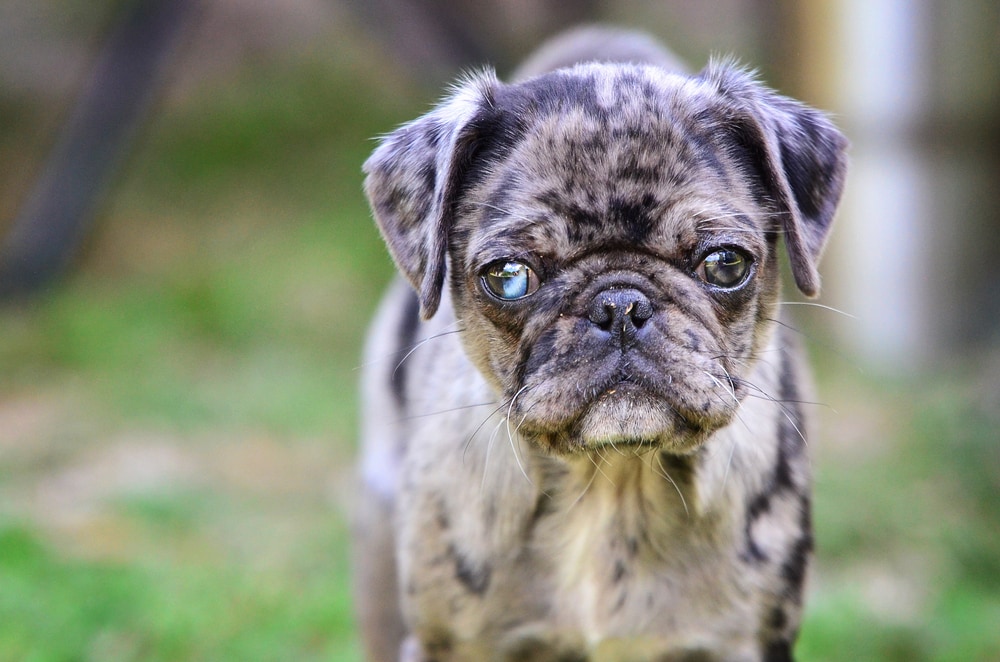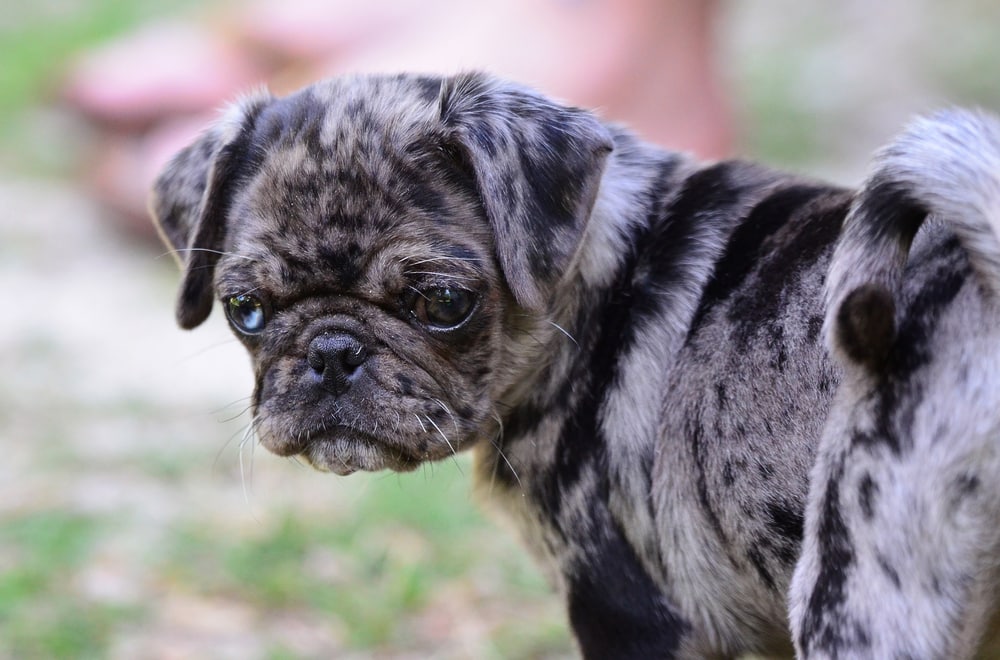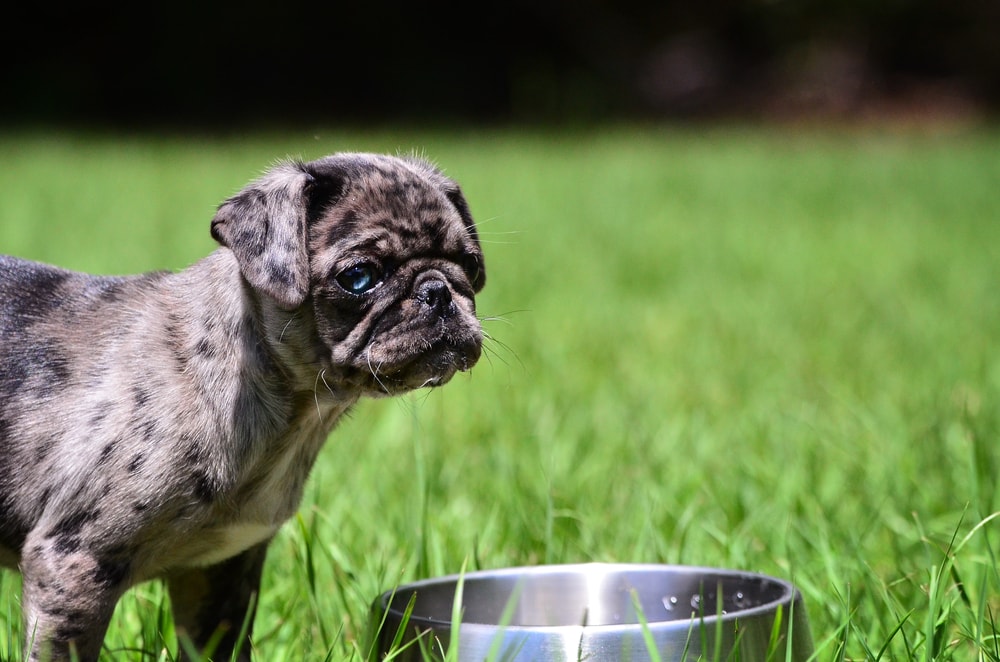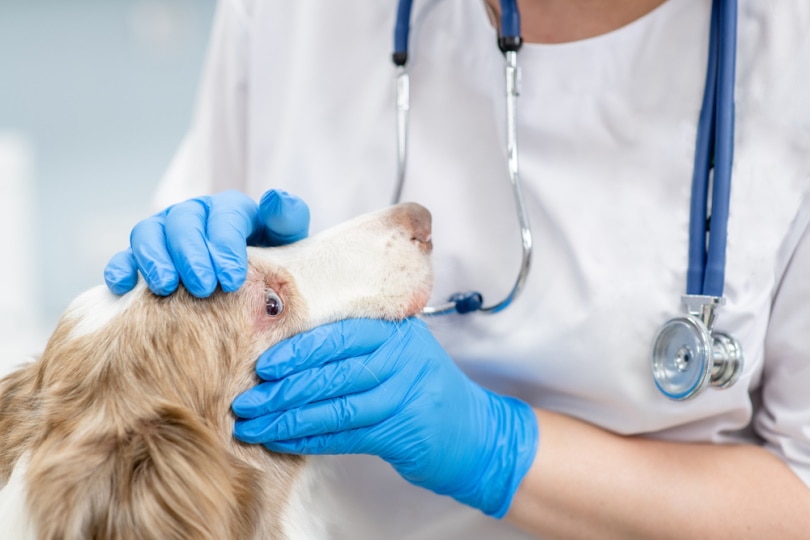Merle Pug: Facts, Pictures, History & Origin

Updated on

| Height: | 10–13 inches |
| Weight: | 14–18 pounds |
| Lifespan: | 13–15 years |
| Colors: | Black, gray, brown, tan |
| Suitable for: | Families looking for a companion dog |
| Temperament: | Fun, loving, loyal, charming, somewhat docile |
The Pug is a very friendly, loyal companion dog and it is a popular toy breed. Typically, it comes in fawn or black colors, but some breeders and owners have bred different colorings into the Pug breed. Merle Pugs are not recognized by the American Kennel Club, and it is a rare variant of the Pug. The coloring needs to be intentionally bred and it must be continuously bred. There are also some health concerns regarding the introduction of the merle gene, which means that a host of kennel clubs and breed groups do not accept the registration of Merle Pugs.
Because Pugs do not naturally have the merle gene, a Merle Pug must have a non-Pug ancestor in its family tree, which means, strictly speaking, Merle Pugs cannot be purebred Pugs. However, they should still have most of the same characteristics and traits as a purebred and they can still make excellent family pets.
Merle Pug Breed Characteristics
The Earliest Records of the Merle Pug in History
The Pug is an ancient breed of dog that most likely originates in China where it was bred as a companion pet for wealthy individuals. It is believed that they date back to 400 B.C. and throughout their long history, they have only ever been used as a companion dog. This means that they have the ideal temperament for a companion dog, being generally happy, and always happiest when they are allowed to spend as much time as possible around their humans.
It is said that the wrinkles on the breed’s foreheads are meant to represent the Chinese symbol for Prince and the name was given because the dog has a similar appearance to that of the “Pug monkey” or marmoset. Others claim that the name comes from the Latin word, “pugnus” which translates as “fist”.

How the Merle Pug Gained Popularity
Having become popular initially in China, the breed spread to Japan and then to Russia before making the journey over to Europe. They did not require a lot of exercise, were small and easy to keep, and they were generally amenable little dogs. This led to the Pug not only becoming popular with everyday people but also with some prominent figures. Catherine the Great of Russia’s aunt had several. Queen Victoria of England and Prince William of Holland also kept Pugs.
Formal Recognition of the Merle Pug
Pugs are generally recognized by most kennel clubs, but the Merle Pug is not, because it cannot be a purebred Pug and there are some concerns over the health implications of breeding the merle gene into the dog.
The Pug was first recognized by the American Kennel Club in 1885 and the United Kennel Club in 1918. The Kennel Club accepts silver, apricot, fawn, or black colored pugs.

Top 3 Unique Facts About the Merle Pug
1. They Have Been Life Savers
Pugs have long been kept by members of royalty from around the world and, in at least one case, even saved members of the royal family. In 1572, Spanish soldiers attempted to kill Prince William of Orange, the Dutch prince, but his Pug, Pompey, heard the assassins approaching and started barking. This alerted the Prince and his men to the presence of the soldiers and his life was saved. As a result, the Pug became the official breed of the House of Orange.
2. They Have Always Been Lap Dogs
While many dogs that we keep as companions today have a history of being used as hunting dogs or other types of working dogs, Pugs have always been bred to be companion dogs and their size has been kept small so that they can comfortably sit on their owner’s lap. They are the epitome of lap dogs.
3. They Are Not Related to Bulldogs
The Pug is sometimes given the nickname Dutch Bulldog, which presumably comes from the fact that the Pug was the official breed of the Dutch Royal Family and has some similar features to the Bulldog. In reality, the breed originates from China, however, and is more closely related to the Pekingese than any Bulldog.

Does a Merle Pug Make a Good Pet?
Pugs generally make excellent pets. They are loving and loyal and enjoy spending as much time as possible with their owners. Although they are lively enough to play games and enjoy a reasonable walk, they do not have excessive exercise requirements, which makes them a good choice for seniors as well as those that don’t have a lot of spare time to walk. And, they are not only understanding of children but they enjoy the attention and especially enjoy spending time with kids that are old enough to be able to throw a ball or toy around for them.
However, it is worth noting that Pugs are somewhat prone to certain health conditions, most of which are related to the brachycephalic face. They can become short of breath and may suffer long-term breathing difficulties, and there isn’t really anything that can be done to remedy the problem. Pugs may also suffer from weeping eyes.
In Conclusion
Pugs are popular pets and are an ancient breed that originate from around 400 B.C. when they were bred as companion dogs or lap dogs for wealthy citizens and royalty in China. Their prowess as companion dogs saw their popularity spread throughout Asia before the dog headed to Europe, where its popularity also spread. Today, the dog is still bred as a lap dog.
While the Merle Pug is popular with some owners, it is not recognized as a Pug by kennel clubs because the merle coloring is not naturally occurring in the Pug breed, and it is believed that intentionally breeding it into Pugs can cause health problems.
- Also see: Best Dog Shampoos – Reviews & Top Picks
Featured Image Credit: Virginia Blount, Shutterstock













